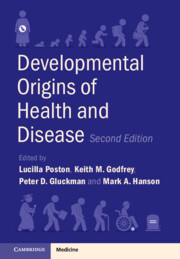Book contents
- Developmental Origins of Health and Disease
- Developmental Origins of Health and Disease
- Copyright page
- Contents
- Contributors
- Preface
- Section I Overview
- Section II Exposures Driving Long-Term DOHaD Effects
- Section III Outcomes
- Chapter 10 Cardiometabolic and Renal DOHaD Outcomes in Offspring of Complicated Pregnancy
- Chapter 11 Developmental Origins of Chronic Respiratory Diseases
- Chapter 12 Early Life Adversity and Female Reproductive Outcomes
- Chapter 13 Developmental Programming of Ageing Induced by Poor Maternal Nutrition
- Section IV Mechanisms
- Section V Interventions
- Section VI Public Health and Policy Implications of Interventions
- Index
- References
Chapter 13 - Developmental Programming of Ageing Induced by Poor Maternal Nutrition
Evidence from Rodent Studies
from Section III - Outcomes
Published online by Cambridge University Press: 01 December 2022
- Developmental Origins of Health and Disease
- Developmental Origins of Health and Disease
- Copyright page
- Contents
- Contributors
- Preface
- Section I Overview
- Section II Exposures Driving Long-Term DOHaD Effects
- Section III Outcomes
- Chapter 10 Cardiometabolic and Renal DOHaD Outcomes in Offspring of Complicated Pregnancy
- Chapter 11 Developmental Origins of Chronic Respiratory Diseases
- Chapter 12 Early Life Adversity and Female Reproductive Outcomes
- Chapter 13 Developmental Programming of Ageing Induced by Poor Maternal Nutrition
- Section IV Mechanisms
- Section V Interventions
- Section VI Public Health and Policy Implications of Interventions
- Index
- References
Summary
Developmental programming predisposes to life-course disease, impairing multi-organ function. Cumulative changes in cellular phenotype influence healthspan and lifespan. Poor maternal nutrition is a major fetal challenge programming changes in offspring phenotype. We review longitudinal studies showing that nutritional programming accelerates sexually dimorphic ageing in multiple organs. Few studies contain the necessary data over multiple life-course ages to evaluate ageing trajectories. We focus on rodent models designed to address influences of maternal nutritional programming of offspring health and evaluate their effects on functional ageing. We report age-related outcomes in offspring of low protein fed and obese, over-nourished mothers. Effects of exercise and dietary interventions are presented to elucidate mechanisms of ageing-programming interactions. We present in vitro and in vivo data on programming-ageing interaction involving the hypothalamo-pituitary-adrenal axis, metabolic, reactive oxygen species (ROS) and reproductive function. We hypothesize that glucocorticoids and ROS represent interactive molecular systems responsible for many programming-ageing interactive outcomes.
- Type
- Chapter
- Information
- Developmental Origins of Health and Disease , pp. 121 - 131Publisher: Cambridge University PressPrint publication year: 2022

